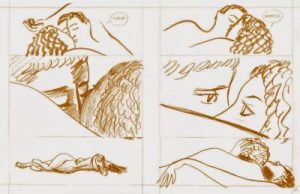Simona Di Rosa wrote a review of Pompei for FuoriPosto on May 23rd 2018. Valerio Stivè translates it from Italian below.
Premiered at Napoli COMICON, Pompeii – a graphic novel published by 001 Edizioni from Torino – is written and drawn by Frank Santoro, and set in Pompeii a few days before the eruption that destroyed the city. The book – a large softcover edition – was published in collaboration with COMICON and the Archeological Museum of Naples, where until May 31st will be hosted an exhibition of original artwork from the book.
Frank Santoro resides in Pittsburgh, where he manages artists’ residencies hosting and helping fellow cartoonists. He is not well known in Italy, and yet he is among the most original voices in contemporary avant garde American comics scene, thanks to Pompeii, published in the USA five years ago. Santoro has an artisanal approach to comics making, using poor tools – mostly pencils and markers – perfect to tell a story set in the ancient Pompeii, showing its historic value while supporting a touching plot, deeply touching despite the unavoidable outcome.
We are in the city of Pompeii, a few day before the eruption. The main character, Marcus, works as an apprentice for Flavius, a portrait painter of some fame. Flavius is married to Alba but has an affair with a princess, from whom he expects love and protection. Marcus has left Paestum along with his girlfriend Lucia, to study as a portrait artist, but his master uses him more to hide his mischiefs to the wife than to work on his art; but Marcus’s search for compensation and success will bring him to make a decision from which one cannot come back. Despite being apparently simple, the story rises from page to page, taking us to an astonishing ending. Most of the script relies on the character’s dialogues, always at a rapid pace and always really plausible. The text, hand lettered by the artist in the original version, in the Italian edition is hand lettered by Silvia Rocchi, adding value to a book that, despite looking so spontaneous, is well thought out in its every detail.
In the pages of Pompeii, the artist draws and writes; at a first glance, the art, made only with pencil and brown marker, looks rough. It feels like reading a story board, rather than a finished work. This partly has to do with the parietal art found in Pompeii, and also, I think, to the way the artist conceived the story: so strong that it does not require more than what it offers. Regardless of the spontaneity of the stroke, there are well pondered panels, effective as much as the expressions of the characters.
The art, in the end, is not just a “piece” of the whole work in its form – it is also a fundamental subject of the story, as a possibility to be something different, representing reality as a desire rather than living it. This multiplicity and intersection of levels is probably striking in terms of color, which are missing in the book, while having an important role in the story – Marcus is the one making the colors for the painter.
Pompeii is a recommended reading, maybe not very accessible (someone could find the book expensive) and maybe arduous for the average reader that would judge a book for its drawings. Now we just have to be ambassadors of this book, to let people discover it over and over, so that it won’t be victim to one of the most dangerous perils of a book the current market: being forgotten before being read. – Simona Di Rosa, for FuoriPosto May 2018

